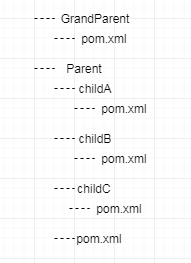以下面dependency为例
1 <dependency> 2 <groupId>javax.servlet</groupId> 3 <artifactId>javax.servlet-api</artifactId> 4 <version>3.1.0</version> 5 <scope>provided</scope> 6 </dependency>
当子工程中引入某个依赖时,可见其设置<scope>provided</scope>,那么后续依赖该工程的所有项目会可能出现找不到这个依赖,原因是:
1.provided是没有传递性的。即,如果你依赖的某个jar包,它的某个jar的范围是provided,那么该jar不会在你的工程中依靠jar依赖传递加入到你的工程中。
2.provided具有继承性,上面的情况,如果需要统一配置一个组织的通用的provided依赖,可以使用parent,然后在所有工程中继承
比如:我现在有个工程结构图如下:

假设GranParent中的pom.xml是个超级pom.xml文件,
Parent继承GranParent
1 <modelVersion>4.0.0</modelVersion> 2 <groupId>com.alice</groupId> 3 <artifactId>Parent</artifactId> 4 <version>1.0.0-SNAPSHOT</version> 5 6 <parent> 7 <groupId>com.alice</groupId> 8 <artifactId>GrandParent</artifactId> 9 <version>1.0.0</version> 10 </parent> 11 12 <modules> 13 <module>childA</module> 14 <module>childB</module> 15 <module>childB</module> 16 </modules> 17 <packaging>pom</packaging>
childA的pom.xml
1 <parent> 2 <groupId>com.alice</groupId> 3 <artifactId>Parent</artifactId> 4 <version>1.0.0-SNAPSHOT</version> 5 </parent> 6 <artifactId>childA</artifactId> 7 8 <name>childA</name> 9 <packaging>jar</packaging> 10 11 <dependencies> 12 <dependency> 13 <groupId>javax.servlet</groupId> 14 <artifactId>javax.servlet-api</artifactId> 15 <version>3.1.0</version> 16 <scope>provided</scope> 17 </dependency> 18 <dependencies>
childB的pom.xml,其中依赖childA
1 <modelVersion>4.0.0</modelVersion> 2 <parent> 3 <groupId>com.alice</groupId> 4 <artifactId>Parent</artifactId> 5 <version>1.0.0-SNAPSHOT</version> 6 </parent> 7 <artifactId>childB</artifactId> 8 9 <name>childB</name> 10 <packaging>jar</packaging> 11 12 <dependencies> 13 <dependency> 14 <groupId>com.alice</groupId> 15 <artifactId>childA</artifactId> 16 <version>1.0.0-SNAPSHOT</version> 17 </dependency> 18 </dependencies>
childC的pom.xml,其中依赖childB
1 <modelVersion>4.0.0</modelVersion> 2 <parent> 3 <groupId>com.alice</groupId> 4 <artifactId>Parent</artifactId> 5 <version>1.0.0-SNAPSHOT</version> 6 </parent> 7 <artifactId>childC</artifactId> 8 9 <name>childC</name> 10 <packaging>jar</packaging> 11 12 <dependencies> 13 <dependency> 14 <groupId>com.alice</groupId> 15 <artifactId>childB</artifactId> 16 <version>1.0.0-SNAPSHOT</version> 17 </dependency> 18 </dependencies>
从上面的pom文件可知,
在childA中,javax.servlet的scope为provided
首先解释下为啥设置为provided:
因为是tomcat中也有servlet-api包,如果默认为compile,即项目在编译,测试,运行阶段都需要这个artifact对应的jar包在classpath中,那么在使用tomcat运行时就会发生了冲突,由于provided只影响编译和测试阶段,在编译测试阶段,我们需要这个artifact对应的jar包在classpath中,而在运行阶段,假定目标的容器(比如我们这里的tomcat容器)已经提供了这个jar包,所以无需我们这个artifact对应的jar包了,那么在实际发布时会默认使用第三方web服务器中提供的jar包,而不会使用本jar包。
由于childB直接依赖childA,所以childB在测试编译阶段可引入servlet-api包,程序可以正常跑通,
但是childC依赖B,而childC也是需要childA中的servlet-api包,但是由于provided没有传递性,scope在不指明情况下默认为copmpile,所以childC和childA是间接依赖关系,所以childC无法引用servlet-api包,导致运行报错,此时需要单独在childC中加servlet-api依赖包,
1 <modelVersion>4.0.0</modelVersion> 2 <parent> 3 <groupId>com.alice</groupId> 4 <artifactId>Parent</artifactId> 5 <version>1.0.0-SNAPSHOT</version> 6 </parent> 7 <artifactId>childC</artifactId> 8 9 <name>childC</name> 10 <packaging>jar</packaging> 11 12 <dependencies> 13 <dependency> 14 <groupId>com.alice</groupId> 15 <artifactId>childB</artifactId> 16 <version>1.0.0-SNAPSHOT</version> 17 </dependency> 18 <dependency> 19 <groupId>javax.servlet</groupId> 20 <artifactId>javax.servlet-api</artifactId> 21 <version>3.1.0</version> 22 <scope>test</scope> 23 </dependency> 24 </dependencies>
什么是传递性依赖(https://blog.csdn.net/lewky_liu/article/details/78145211)
有时候我们在pom.xml文件中引入的依赖,其本身就需要依赖于其他的依赖,这时候我们不需要去考虑这些依赖,Maven会解析各个直接依赖的pom,将那些必要的间接依赖,以传递性依赖的形式引入到当前的项目中。
通过传递性依赖,我们可以在pom.xml文件中少写不少的依赖配置
传递性依赖的依赖范围
假如当前项目为A,A依赖于B,B依赖于C。此时称A对于B是第一直接依赖,B对于C是第二直接依赖,而A对于C是传递性依赖。只要知道B在A项目中的scope,就可以知道C在A中的scope。其依赖范围如下:
表格的第一列是B在A中的依赖范围,第一行是C在B中的依赖范围,交叉的格子是C在A中的依赖范围

当C在B中的scope为test时,A不依赖C,C直接被丢弃
当C在B中的scope为provided时,只有当B在A中的scope也是provided时,A才会依赖C,这时候C在A的scope是provided
当C在B中的scope为compile或runtime时,A依赖C,此时C在A中的scope继承自B在A的scope。注意,如果C的scope是runtime,B的scope是compile,此时C在A的scope是runtime,而不是compile
参考https://blog.csdn.net/u013704227/article/details/46460913
https://blog.csdn.net/lewky_liu/article/details/78145211